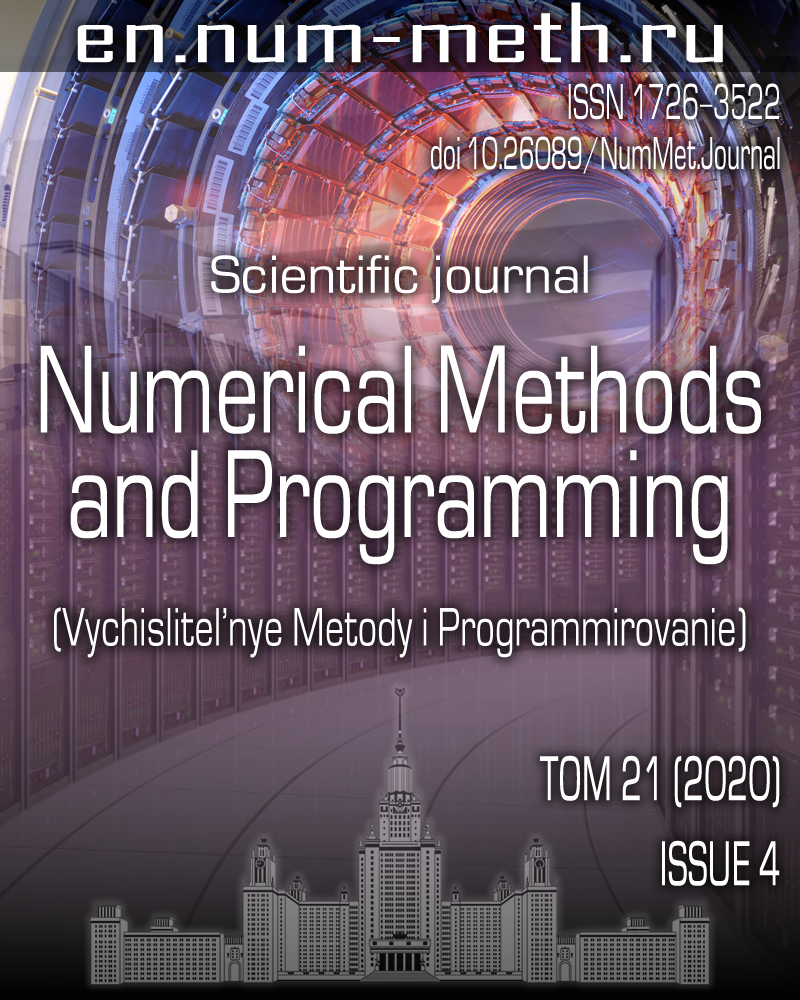DOI: https://doi.org/10.26089/NumMet.v21r434
Numerical simulation of a slow extraordinary wave in magnetoactive plasma
Keywords:
Abstract
The effect of an external magnetic field on plane non-relativistic nonlinear plasma oscillations is studied numerically and analytically. A method for the initialization a slow extraordinary wave in a magnetoactive plasma is proposed for constructing the missing initial conditions based on solving a linear problem using the Fourier method. For the purpose of numerical simulation of a nonlinear wave, a scheme of the second-order accuracy finite difference method of the MacCormack type based on Euler variables is constructed. It is shown that, when the external magnetic field is taken into account, the Langmuir oscillations are transformed into a slow extraordinary wave whose energy vibrates when moving from the origin. In this case, the wave velocity increases with the growth of the external constant field, which contributes to the removal of energy from the initial region of localization of oscillations.
Published
Issue
Section
References
- R. C. Davidson, Methods in Nonlinear Plasma Theory (Academic, New York, 1972).
- E. V. Chizhonkov, Mathematical Aspects of Modelling Oscillations and Wake Waves in Plasma (Fizmatlit, Moscow, 2018; CRC Press, Boca Raton, 2019).
- A. F. Aleksandrov, L. S. Bogdankevich, and A. A. Rukhadze, Principles of Plasma Electrodynamics (Springer, New York, 1984; Vysshaya Shkola, Moscow, 1988).
- V. L. Ginzburg and A. A. Rukhadze, Waves in Magnetoactive Plasma (Nauka, Moscow, 1975) [in Russian].
- V. Krasovitskiy and A. Bugrimov, “Acceleration of Electrons in the Field of a Light Wave in Magnetoactive Plasma,” Vestn. Mosk. Gos. Oblast. Univ., Ser.: Phys. Mat., No. 1, 31-43 (2016).
- A. Moradi, “Energy Behaviour of Extraordinary Waves in Magnetized Quantum Plasmas,” Phys. Plasmas 25 (2018).
doi 10.1063/1.5031753 - V. P. Silin, Introduction to Kinetic Theory of Gases (Nauka, Moscow, 1971) [in Russian].
- V. P. Silin and A. A. Rukhadze, Electromagnetic Properties of Plasma and Plasma-Like Media (Librokom, Moscow, 2012) [in Russian].
- A. A. Frolov and E. V. Chizhonkov, “Application of the Energy Conservation Law in the Cold Plasma Model,” Zh. Vychisl. Mat. Mat. Fiz. 60 (3), 503-519 (2020) [Comput. Math. Math. Phys. 60 (3), 498-513 (2020)].
- C. J. R. Sheppard, “Cylindrical Lenses - Focusing and Imaging: A Review [Invited],” Appl. Opt. 52 (4), 538–545 (2013).
- E. V. Chizhonkov and A. A. Frolov, “Influence of Electron Temperature on Breaking of Plasma Oscillations,” Russ. J. Numer. Anal. Math. Modelling 34 (2), 71-84 (2019).
- R. W. MacCormack, “The Effect of Viscosity in Hypervelocity Impact Cratering,” J. Spacecr. Rockets 40 (2003).
doi 10.2514/2.6901 - D. E. Potter, Computational Physics (Wiley, London, 1973; Mir, Moscow, 1975).
- Yu. I. Shokin and N. N. Yanenko, Method of Differential Approximation: Application to Gas Dynamics (Nauka, Novosibirsk, 1985) [in Russian].
- D. A. Anderson, J. C. Tannehill, and R. H. Pletcher, Computational Fluid Mechanics and Heat Transfer (Hemisphere, New York, 1984; Mir, Moscow, 1990).
- Z. I. Fedotova, “On the Application of the MacCormack Scheme for Problems of Long Wave Hydrodynamics,” Vychisl. Teknol. 11, Special Issue, 53-63 (2006).
- E. V. Chizhonkov, “On Second-Order Accuracy Schemes for Modeling of Plasma Oscillations,” Vychisl. Metody Programm. 21 (1), 115-128 (2020).
- A. A. Frolov and E. V. Chizhonkov, “Numerical Modeling of Plasma Oscillations with Consideration of Electron Thermal Motion,” Vychisl. Metody Programm. 19 (2), 194-206 (2018).
- C. Maity, Lagrangian Fluid Technique to Study Nonlinear Plasma Dynamics, PhD Thesis (Saha Institute of Nuclear Physics, Kolkata, 2013).
- P. N. Swarztrauber, “Vectorizing the FFTs,” in Parallel Computations (Academic Press, New York, 1982), pp. 51-83.


